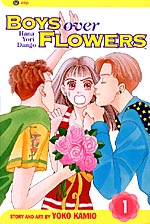 By Yoko Kamio
By Yoko Kamio
216 pages, black and white
Published by Viz
If there’s one thing that reading Japanese comics has taught me, it’s that their school system is set up very differently than ours. What school you go to carries a great amount of prestige, with parents often spending a great deal of money to get their children into a school that will look good when promotion time comes around. When reading Boys Over Flowers: Hana Yori Dango, I also got another very important lesson—that if Japanese schools are really like this, they’re very much not the place for me.
Tsukushi Makino is attending Eitoku Academy, a place primarily populated by the children of rich parents. Makino’s parents are anything but rich, but they want Makino to have this opportunity so she’s reluctantly attending. The worst thing about Eitoku Academy is how four rich boys called “The F4” essentially rule the school; get on their good side and you’re part of the hip, happening crowd that everyone loves. Get on their bad side and you’re driven out of school, your life made so miserale that you’ll be desperate to return to a lower-class existence. When Makino stands up for one of her only school friends that accidentally falls on top of one of the F4, Makino becomes the F4’s next target. What the F4 has never had until now, though, was a “victim” who’s ready to fight back…
I think what I liked the most about the first volume of Boys Over Flowers was watching Makino stand up in the face of adversity and show what she’s made of. Before the F4 targets Makino, she’s a very wishy-washy person who seems to alternate between indignation and fading into the background; she’s got the spark of wanting to act but never seems to actually do so. Necessity may be the mother of invention, but it’s also the the father of action. It’s the tougher Makino that I find more likable, and to be honest, I think her schoolmates feel the same way. Now I’m not saying that the F4 did a good thing by targeting Makino—trying to get her raped is a pretty reprehensible action, and I’m glad that with the buds of romance between Makino and the F4 that it wasn’t something that most of the F4 agreed with—but in the end she’s a stronger person that’s going to get much farther in life. Speaking of romance, it was nice to see that the start of Makino and Rui’s connection is handled delicately; Rui’s disenchantment with the rest of the F4 is nicely played, and I appreciate that it’s not an immediate, “I love him but I must hate him!” sort of thing. (Wonderfully, Domyoji’s infatuation with Makino coupled with his status as leader of the F4 seems to be a great parody of that sort of thing.)
As fun as Yoko Kamio’s story in Boys Over Flowers is, the art is merely average. That’s not to say that it’s particularly bad, but merely that nothing really jumped out at me. The art flows cleanly from panel to panel, and there are one or two moments that work really well—the final moment of the first volume had a perfect expression on Makino’s face, as well as the looks of anger and surprise when Makino declares war on the F4—but in the end, the art merely works. Which, if you think about it, is just fine.
High school is rough, but I’m starting to think that it’s all a drop in the bucket compared to what can really go on in those teenage years. Maybe that’s why at the end of the first volume is a bonus story about a woman feeling she’s predestined to fall in love with someone else; it’s a more upbeat, happy story that is a nice contrast to the rest of the book. Tragically, it’s “to be continued” but that’s ultimately just another thing to look forward to. Me, I’m just glad Boys Over Flowers: Hana Yori Dango is fiction because you’ll also find yourself wishing bad things on Makino just to see how she’ll react. Who knew cheering on torment would be so much fun? Boys Over Flowers is on sale at better comic book stores everywhere.
Purchase Links:
